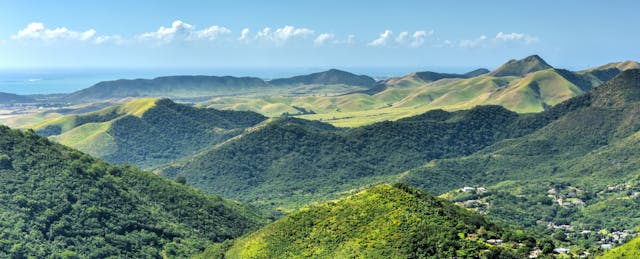My Great-Tio Yia’s house is an anchor for my family in Puerto Rico. Perched on a parcel of my Great-Grandfathers once expansive sugar cane farm, or “la finca,” it is a simple, but elegant house, with a balcony that overlooks the expanse of the land. Inside, large gubernatorial portraits of Luis Muñoz Marín, the first democratically elected Puerto Rican governor, are prominently displayed next to family photos and Catholic saints.
Every time I would visit, Tio Yia would host us around his kitchen table and speak to the history of our hometown, our family (he was one of twelve) and la finca. The stories would inevitably circle back to Governor Muñoz Marín’s legacy, and how he brought industrialization to the mountains. Muñoz Marín is often revered for his work leading Operation Bootstrap—an initiative to upgrade the infrastructure and economy of Puerto Rico in the 1950s and ‘60s. One key goal was to lay a comprehensive power grid; however, one large barrier remained—the terrain. The inland areas of Puerto Rico are covered by hard-to-navigate mountain ranges; often, only the “Jíbaros,” slang for Puerto Rican mountain farmers, really know the nooks and crannies of this mountainous region.
Legend has it that my great-grandfather and two great-tios got word of Muñoz Marín’s initiative. Longing to bring the power of electricity to the farm, they organized a small group of neighbors at the local church, mandating that Luis Muñoz Marín come to our small town, linemen and tools in tow. It worked. Muñoz Marín came to the church. He relied on the native expertise of the town, and together, the government and the townspeople designed a solution that successfully brought electricity to the region. Finally, our barrio was illuminated with the technology of the 20th century. Beyond our town, Muñoz Marín’s administration replicated this practice throughout isolated barrios in Puerto Rico; eventually, industrialization was brought to the island as a whole.
More than a decade ago, I started my career as a middle school math teacher in my hometown, Kansas City, Mo. My students were brilliant and determined, but they hadn’t gotten the education they deserved; 93 percent of them were performing below grade level. The majority of them were Black and Latinx, living in neighborhoods with limited access to economic or educational resources.

The schools I taught in wanted for the most basic school supplies: working copy machines and classrooms that didn’t flood when it rained. While the world outside my classroom was experiencing an unprecedented technological revolution, I was tasked with preparing my students for an increasingly complex future, armed with nothing more than broken pencils and outdated textbooks, constrained by the burdens of an imposed high-stakes testing culture.
You could make the argument that my classroom was like la finca of my great tio’s generation—tio and his neighbors watched as agricultural life elsewhere was disrupted at the hand of industrialization. They understood the implications and they yearned to participate in this great change.
And this is when it struck me; if we are to be serious about giving every child a shot at realizing their full potential, then children and their teachers, especially those in under-resourced communities, deserve access to every single advantage. In 2020, this means access to cutting edge tools and resources built by advanced technologists, leveraging learning science and informed by the unique needs of the children and teachers they impact.
Yet, the way they get access to such resources matters just as much.
Muñoz Marín knew this. He knew that he couldn’t successfully implement the grid to scale throughout the mountains—a terrain he had no direct knowledge of—alone. He needed the willing and enthusiastic expertise of the Jíbaros.
And herein lies the similarities; creating great change in underserved education communities is akin to making great infrastructure change in remote parts of a rural island. Given our nation’s vast and diverse landscape, we can no longer pretend that a one-size-fits-all strategy will work. Instead, we need to find a way to marry cutting-edge technologies with the unmarked terrain and vast nuances of our American classrooms. For this to work, the process cannot be run by outsiders. It must be initiated and guided by the true experts, the Jíbaros of the classroom—the teachers and students.
I left the classroom 6 years ago to found a nonprofit organization called LEANLAB Education to realize this goal. Our mission is to launch transformational education innovations that have national impact—built by, for, and with our local communities. By doing so, we dream of connecting all classrooms with the technology they need.
At the core of our work are two principles that can be applied broadly throughout education:
1. Those closest to the issues of education, including students, teachers and families, should lead their own innovation process. Like my great grandfather, tios, and their neighbors, our school communities should have the resources to self organize; they should be identifying the technologies and resources they need to prepare students for the future, and they should be able to demand access.
2. Innovations should be implemented, studied and modified in collaboration with school communities. Context matters—even a proven, scalable technological advancement like electricity needed the expertise of the local community for a successful implementation.
School communities need and deserve meaningful agency.They must define their own innovation challenges and design their path forward, upending the traditional top-down structure, thus creating a true education revolution.
So what do these principles look like in practice? We see it translated to a three step process.
Step 1
School Communities Define The Change They Want to See
In Puerto Rico, this was the neighbors gathering at church, demanding access to electricity.
- Educational innovation must begin with disciplined and earnest listening. Decision makers (superintendents, nonprofit leaders, funders, policy makers) must convene, interview and survey educators, parents and families in zip codes where inequities persist. The education community needs to be the one naming the most pressing challenges in schools today. They need to be the ones describing their aspirations for the future.
- Innovators can then use that material—with care—to seek patterns and trends. They can’t speak for those they met with, but they can organize what they heard into themes, bringing forth and bridging the words of many into clear innovation priorities.
In 2018, during interviews my organization conducted with a diverse set of community members, some distinct themes emerged across all stakeholders when asked for priorities they wanted to emphasized by their districts. Life skills, such as critical thinking, communication, living in a pluralistic society and survival skills all bubbled to the top. But so did more varied education experiences, improved literacy instruction and mental health supports.
Step 2
School Communities Co-Design Emerging Solutions
In Puerto Rico, this meant that Muñoz Marín sought local knowledge of the terrain, which guided the laying of the electrical lines.
- School Communities Find a Match: Education innovators, such as engineers and entrepreneurs, can then find leaders within school communities—typically educators—who identify with revealed innovation priorities. They can equip them with training in design thinking and innovation frameworks; together, this new coalition of innovators and educators can learn how to define “pain points,” prototype potential solutions and describe the solutions they want to see.
At LEANLAB, that means that when school and community leaders tell us about their needs, we listen. Then, we curate a short list of top innovators from across the world who are designing new technologies, processes and products that are aligned to our school communities’ needs.
Our school community leaders then choose which innovations they’d like to pilot at a facilitated event called Match Day. The chosen innovators come to Kansas City to work hand-in-hand with our school community leaders for a 6-month pilot study.
Those school community leaders and innovators then co-design a research question, hypothesis and implementation plan for a pressing problem. For the next 6 months, they measure the solutions’ early impact in rigorous pilot studies. School community leaders give indispensable feedback to the innovators, who modify their solutions in response.
Step 3
Coordinated Scale
In Puerto Rico Marín replicated this process of using the Jíbaros’ expertise to understand the terrain throughout the island to bring light to every corner of the mountainous regions.
- Share what you’ve learned. Innovators shouldn’t keep their learning to themselves. At the close of a pilot, we share what we’ve learned in a published mini-study. We cite research findings of the innovations’ effectiveness (or ineffectiveness) and the school community leader’s recommendation for next steps.
- Coordinate decision making. At LEANLAB, following a pilot, we gather system level leaders from school districts and adjacent school communities. Our school community leaders make vocal recommendations about their piloted solutions; in doing so, they may recommend a deeper pilot study, the scale-up of an innovation or the discontinuation of the solution if the evidence doesn't bear out its effectiveness.
- Activate toward scale. With thoughtful, deliberate planning, great ideas can grow. After we gather the recommendations of school community leaders, we facilitate a coordinated decision making process with the school system-level leader. Our school-community leaders present their evidence and recommendations themselves, directly influencing how scale-up decisions are made.
It’s worth returning to our analogy. After electricity was brought to our barrio, many left the farm communities—and the island—in search of opportunity. But my two favorite uncles, Great-Tio Yia and his brother Tio Edwin, stood defiant. Instead of leaving the farm, they built homes within eyesight from one another, on the same plot of land as my great-grandfather’s farmhouse. Irreverent symbols. Siempre Jíbaro.
As Hurricane Maria made landfall in September 2017, she carved her path across my family’s finca, en route to her greatest destruction in the central mountains. Of course, on her way, she took the the electrical grid with her.
For seven months my family endured without electricity. They got by with the help of diesel-generators, a common possession on an island with frequent black-outs caused by the decaying electrical grid.
My family’s dependence on diesel, however, was greater than most. One of my great-tios was oxygen dependent, and one of my great-tias needed both oxygen and cancer treatments. The demands of the oxygen compressors kept the generators rumbling continuously, a constant hum against the countryside, spewing their ever-present clouds of black smoke. And daily, my tio or tia would labor over the generator, siphoning diesel into the loud machines, mouths covered by handkerchiefs.
Within 18 months of Maria’s landfall, three of my family members would be dead—both my great-tios and my great-tia. In my family’s small town, the town doctor and neighbors will tell you, in hushed whispers between prayers, that it was the stress, the heartbreak and the diesel that killed them. The electricity had been a lifeline in so many ways.

“Tormenta” translated in English means storm; or, as its English cognate, torment—physical or emotional suffering. While it was a natural disaster that caused the Category 4 tormenta, it was the man-made response of the American government that contributed to the nearly 3,000 deaths after the storm, and the ongoing suffering of the Puerto Rican people. The United States is no stranger to dynamic disaster relief—the technology and resources exist. Weeks before Maria, the United States led effective relief efforts in Texas and Florida after hurricanes Harvey and Irma; it’s no secret that the amount of relief given to the American states far exceeded the aid given to Puerto Rico. Instead of coordinating an effective relief response in Puerto Rico, the United States hid behind the island’s commonwealth, or colonial, status; while Puerto Ricans are United States citizens, they are without voting representation in congress—and it was congress that approved a meager, insufficient disaster relief plan and impeded the distribution of much-needed aid to Puerto Rico. In short, our island found itself, quite literally, powerless, in a time of extreme need.
It’s not lost on me that the designation of a “commonwealth” is used for an island populated by Spanish speaking, brown bodies; that this painful withholding of decision making authority and life-bearing resources fundamentally signals a distrust of our people, and their ability to solve their own problems. Instead, a governing body—distanced by thousands of miles—prescribed an ineffective solution for a distant and different population, without their input. And the result was the death of 3,000 people.

While this story is personally devastating, the narrative is familiar. The trope is simple; black and brown communities are deemed incapable of self-governance and self-determination; they are not to be trusted with the most basic of resources, let alone to innovate the cutting-edge solutions that could propel them forward, undoing decades of systemic oppression.
This same pernicious narrative finds its way into the intersection of public education and technology too.
In many ways, Kansas City mirrors the national landscape of education reform efforts of the last twenty years. We are a city with a prominent charter school sector, large education-focused philanthropies and a high-stakes accountability culture. Our urban schools serve predominantly Black, Latinx and immigrant children living in poverty. Over the last decade, multiple change efforts have occured; school closings, school reopenings, new nonprofit services, new funding strategies, etc. Yet growth in educational outcomes for our city’s children has remained incremental at best.
However, I believe it’s time to bring forth another way, the same one that worked in my family’s barrio not all that long ago. We are looking straight ahead into a new decade with the knowledge that technology is advancing at rates faster than we can comprehend. Our children will leave their classrooms into a future that is increasingly unknown. So we must ask ourselves: what is the purpose of innovation? Who should be doing the innovating? And what are we, collectively, innovating for?
Let’s return to Puerto Rico. Its people and its land are so resilient. The earth itself has grown back vibrant; our land on la fincas is green as it has ever been. My family is strong, well, brilliant, loving. And, back in Kansas City, so are my former students and former colleagues.
Innovators will only make real progress when they listen to those they’re innovating “for”—my family in Puerto Rico, my former students and classroom teachers. If their goal is truly to make life easier and better, to democratize access to life-changing knowledge and tools, they must invest in the context, strength and brilliance of those who stand to gain the most from their use. Otherwise, their innovations are simply replicating oppressive structures of power.
If we want to truly innovate for good, I’ve got a simple, cheap and effective way. It’s that 3-step process: listen, co-design and facilitate scale. I am confident it can work. But I know it will require radical trust, a redistribution of access and for many of us, the willingness to get out of the way.


